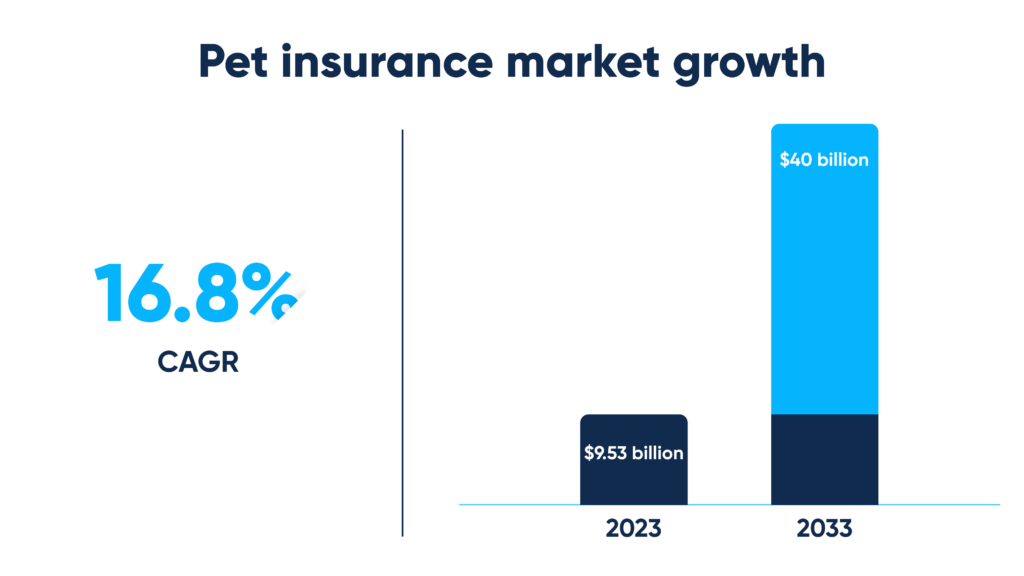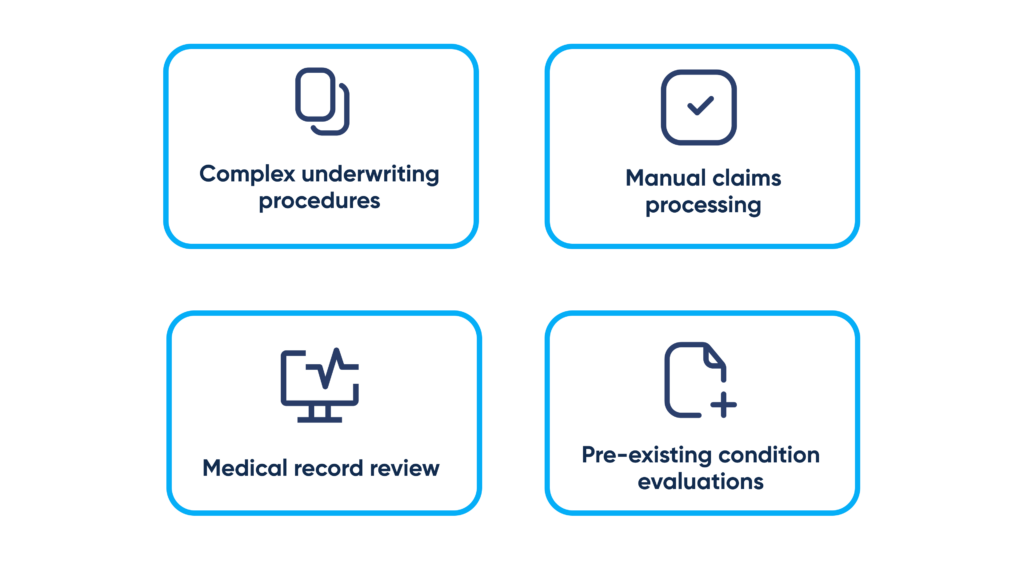Artificial intelligence to minimize pet insurance waiting periods

Pet insurance has seen great changes, with more pet owners now recognizing the importance of protecting their four-legged family members to be better prepared in case of emergencies, injuries, illnesses, and more. With increasing adoption rates, the segment is now looking ahead to its next target: technology integration.
But what are the main opportunities to focus on for business leaders in the pet insurance industry today?
Pet insurance market overview

As to different sources:
- The global pet insurance market size was valued at over $8.6 billion in 2022
- The global pet insurance market size is estimated at over $9.5 billion in 2023 and expected to reach $40 billion by 2033, dynamically advancing at a compound annual growth rate of 16.8%
One reason for growth is the rising number of adoptions being caused by the COVID-19 outburst and lockdown. Other factors are the increasing acceptance of specialized pet insurance (dog insurance, cat insurance), dynamically rising veterinary costs, and personalized pet policies.
Pet insurance meets innovation – new trend to watch
The landscape has changed – pet owners are buying organic foods, hiring services, and hosting “pet parties”. The customer, now being more demanding than ever, is expecting customer-centric services, a personalized, interactive experience, and, accordingly, quicker services.
That’s where digital transformation becomes essential for companies moving towards higher competitiveness. To leverage future-proof opportunities, more and more organizations are implementing artificial intelligence, ML, DL, wearable devices, and other modern-day solutions.
Let’s continue with a comparison of pet insurance providers enjoying great popularity.
Pet insurance provider comparison: ratings, coverage, deductibles, reimbursement
We took the time to compare some popular pet insurance providers operating in the United States of 2023:
| Forbes rating | Annual coverage | Deductible choices | Reimbursement choices | |
| Paw Protect | 5.0 | $5,000, $10,000, Unlimited | $100, $250, $500 | 70%, 80%, 90% |
| Pets Best | 4.0 | $5,000, Unlimited | $50, $100, $200, $250, $500, $1,000 | 70%, 80%, 90% |
| Embrace | 5.0 | $5,000, $10,000, Unlimited | $100, $250, $500 | 70%, 80%, 90% |
| Spot | 5.0 | $2,500, $3,000, $4,000, $5,000, $7,000, $10,000, $15,000, $20,000, Unlimited | $100, $250, $500, $750, $1,000 | 70%, 80%, 90% |
| Pumpkin | 4.5 | $10,000, $20,000, Unlimited | $100, $250, $500 | 90% |
| Lemonade | 4.0 | $5,000, $10,000, $20,000, $50,000, $100,000 | $100, $250, $500 | 70%, 80%, 90% |
Top insurance plans close-up: the pros and cons
User ratings, deductible and reimbursement choices, and other policy details are definitely worth considering, but these are mostly quite similar from provider to provider when you look at pet insurance comparison charts. We reviewed the currently available plans and highlighted the providers’ key advantages and disadvantages.
Paw Protect
The pros:
- A virtual credit card with a $2,000 line of credit is issued to pay vet bills
- Covers the veterinarian office visit fee for illness and accidents
- Has a “diminishing deductible” with a $50 reduction every year if you don’t make a claim
- Only 2-day waiting period for accident vet coverage
The cons:
- Lacks options for both annual coverage and deductibles
- A 6-month waiting period for coverage of orthopedics
Pets Best
The pros:
- A range of different deductible choices
- Can pay vets directly
- Has a multipet discount of 5% per pet
- Only 3-day waiting period for accident vet coverage
The cons:
- Doesn’t cover alternative therapies, unlike many other plans
- A 6-month waiting period for coverage of cruciate ligament issues
Embrace
The pros:
- An optional wellness plan
- Covers the veterinarian office visit fee for illness and accidents
- Has a “diminishing deductible” with a $50 reduction every year that you don’t make a claim
- Only 2-day waiting period for accident vet coverage
The cons:
- Lacks options for both annual coverage and deductibles
- A 6-month waiting period for coverage of orthopedics
Spot
The pros:
- Low $100 deductible available
- Covers the veterinarian office visit fee for illness and accidents
- Has a multipet discount of 10% per pet
- Covers microchips
The company has a good rating and offers attractive options, including a quite competitive multipet discount. But, however, a disadvantage worth mentioning is the inconvenient 14-day accident waiting period that might turn away potential customers.
Pumpkin
The pros:
- A 90% reimbursement level for dogs and cats that are 8 weeks and older
- Covers veterinarian exam fees for illnesses and accidents
- Has a multipet discount
- No special waiting period for problems such as knee injuries, hip dysplasia, and similar
The cons:
- No accident-only plan available
- A 14-day accident waiting period (some competitors offer a 1- or 2-day only waiting period)
Lemonade
The pros:
- An optional wellness plan
- Has the lowest prices for insuring young pets among the analyzed plans
- Has a live chat
- Only 2-day waiting period for accident vet coverage
The cons:
- A 6-month waiting period for coverage of cruciate ligament issues
- The coverage for vet exam fees has to be added for an extra cost
- No coverage for behavioral or alternative pet therapy
- No coverage for stem cell treatment, prescription food, and microchipping
Among these providers, only Lemonade utilizes artificial intelligence with advanced algorithms for quicker claims processing.
Decoding delays: the causes behind lengthy waiting periods
If concluding from this brief review, waiting periods seem to be the main issue associated with pet insurance. Those policyholders experiencing delays might struggle with achieving customer satisfaction and retention, potentially suffering reputational and financial damage.

The long waiting periods associated with pet policies are primarily due to several factors related to:
Complex underwriting procedures
Underwriting procedures involve assessing various factors – breed, age, health history, hereditary conditions. Data collection, processing, storing, and management are traditionally performed manually and, accordingly, quite resource-intense.
Manual claims processing
Claims processing involves careful account review, coverage cross-checking, legitimacy verification, and more. As these day-to-day processes are typically handled manually, they appear quite labor-intense and inefficient.
Pre-existing condition evaluations
Distinguishing between pre-existing conditions and recently emerged problems is a process necessitating thorough examination, oftentimes requiring back-and-forth communication with involved veterinary offices. Without automation, this process can take quite long.
Medical record review
Medical records are hard-to-review, often compounded if there are discrepancies and missing health details. Without automation tools incorporated, the process can take several weeks.
Introducing innovation – AI integration to reduce waiting periods
So what are the AI in pet insurance use cases talking about waiting periods?
There are multiple reasons forward-thinking leaders should focus on minimizing pet insurance waiting periods. These include operational efficiency, customer loyalty, market growth and expansion, regulatory compliance, and other critical factors severely influencing business sustainability.
Artificial Intelligence can expedite various processes, thereby minimizing waiting periods in the following ways:
Risk assessment
AI solutions can automate risk assessment by analyzing data regarding breed, age, health history, and others. Advanced algorithms can identify risk factors, helping make faster decisions.
For example:
Pumpkin’s coverage hasn’t special waiting periods for problems such as knee injuries, hip dysplasia, and similar. By using AI-based tools, the provider can shorten the standard waiting periods for more complex conditions, which require extensive underwriting, thus offering more attractive animal life insurance options.
Claims processing
AI software can handle claims processing by extracting and analyzing submitted information from documents. Trained algorithms can validate claims against policy details, helping facilitate reimbursement approval.
For example:
Spot’s coverage includes a low $100 deductible option and other unique benefits like coverage for microchips. By using claims processing automation software, the provider can minimize the standard 14-day accident waiting period to ensure quicker resolutions for options from illness and accident to microchipping and attract even more potential customers.
Decision-making support
Artificial intelligence can analyze health records and identify pre-existing conditions quicker than human staff. Such solutions detect indications of chronic health conditions, speeding up policy decisions.
For example:
Embrace’s quite limited options is an area where AI-based automation can provide decision-making support. Advanced algorithms can introduce and assess new options for both annual coverage and deductibles, eventually enabling more accessible veterinary care.
Data interpretation
By adopting modern techniques – natural language processing (NLP), optical character recognition (OCR) – strategic leaders can digitize and interpret medical records much faster than utilizing traditional methods. Modern software can highlight relevant information, significantly facilitating overall efficiency and eliminating human error.
For example:
Lemonade’s distinctive low pricing for insuring young pets is another realm where AI-driven tools might help. Smart algorithms can adjust pricing models and policies by enabling automation of claims processing, potentially minimizing waiting periods for adjustments and clarifications associated with coverage details.
An intelligent virtual assistant to automate documentation tasks
At Humana, one of North America’s most prominent health insurers and providers, the implementation of a virtual assistant named Allie has marked significant improvements in their workforce dynamics and efficiency. Specifically designed to minimize documentation workload, the robot has shown great potential in facilitating operational productivity.
Joe Bechtel, the principal of automation strategy advancement at Humana, has shared the findings of an internal investigation:
- Before Allie, healthcare professionals were spending approximately 80% of time on day-to-day documentation routines (care plans, medical charting)
- With Allie, the organization has seen a decrease of up to 15% in repetitive documentation processes, which empower the staff to dedicate more time to attentive patient-first care
Only 30 “digital workers” to save 100,000 hours
The process unfolding in New Mexico after a new baby is born is intricate – a complex, bureaucratic procedure. Before implementing computational technology, hospital workers would manually enroll newborns in Medicaid, a US state program that provides health insurance for adults and children, which could last a whole month. Since 2020, New Mexico has embraced artificial intelligence by collaborating with IBM and SS&C Blue Prism – when a new child is born, its details are entered by a healthcare professional utilizing an intelligent chatbot. This process became remarkably more efficient, taking about 10 minutes from A to Z.
This procedure is one among many other tasks now handled by 30 digital workers employed in New Mexico. The robots are projected to save more than 100,000 hours human labor every year.
How we can help
The applications of advanced AI in pet insurance are countless, so why delay modernization?
Abto Software sees future-proof business opportunities in implementing artificial intelligence to revolutionize pet insurance, from accurate claim processing and 24/7 customer service, to hassle-free regulatory compliance. Our teams can leverage computational technology – artificial intelligence, ML, DL, NLP, OCR, computer vision – and cover every stage from design to deployment to empower business leaders in their digitization journey.
Our expertise:
- Artificial intelligence
- Computer vision
- Natural language processing (NLP)
- Optical character recognition (OCR)
Contact us to create unique insurance products leveraging domain-specific expertise.
FAQ
By integrating artificial intelligence, insurance providers can optimize:
- Risk assessment
- Claims processing
- Decision-making support
- Data interpretation
And other inevitable processes, which require significant resources – time, costs, and notable human effort.
The customers are typically always elaborating: “So, is pet insurance worth it for an indoor cat or is it scam?”.
By adopting artificial intelligence, insurance companies might automate critical operations handled everyday. This means operational efficiency, market growth and expansion, regulatory compliance, and, accordingly, customer satisfaction and retention.
Don’t wait for customers to ask themselves “is dog insurance worth it?” after awaiting the payment for months.
To protect our clients and eliminate reputational and financial damage, our engineers:
- Employ algorithms with built-in privacy safeguards
- Ensure compliance with acknowledged regulatory requirements
- Implement protocols for sensitive data transmission
- Utilize role-based access controls, and more
When implementing artificial intelligence, there are some limitations worth considering:
- Algorithmic bias
- Contextual misunderstanding
- Adaptability and employee training
- Interpretability and transparency issues
- Technical challenges
- Regulatory limitations


